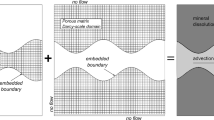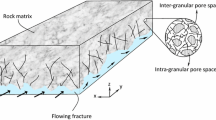Abstract
The planned high-level nuclear waste repository at Forsmark, Sweden, will accommodate 6,824 containers with a total of 13,920 tonnes of uranium in burnt fuel at approximately 400 m depth in a fractured-granite aquifer. The transport of radionuclides, which may be released from the disposed waste, is simulated with the TOUGHREACT code for a three-dimensional model with 305,571 elements. The model performs coupled flow-transport simulations. It aims to achieve more realistic simulations of contaminant transport than the commonly used decoupled procedure consisting of three-dimensional flow and one-dimensional transport simulations. The model has a relatively small problem size because it is designed as a double-porosity model (one matrix continuum) that is the parameterised equivalent of a much larger multiple-interacting continua (MINC) model, i.e. a model with a finely discretised matrix (several matrix continua). The parameterisation is performed with two-dimensional models. Only one or two variables among three variables (diffusive transport distance between fracture and matrix, retardation factor and effective diffusivity) have to be parameterised. The results obtained with the parameterised three-dimensional model are very close to those that can be obtained with a much larger MINC model but may be quite different from those that can be obtained with the conventional decoupled procedure.
Résumé
Le site de stockage de déchets hautement radioactifs projeté à Forsmark, Suède, contiendra 6,824 containers avec un total de 13,920 tonnes d’uranium dans du combustible usagé à une profondeur approximative de 400 m dans un aquifère granitique fracturé. Le transport des radionucléides qui peuvent être relargués par les déchets entreposés est simulé à l’aide du code TOUGHREACT pour un modèle tridimensionnel avec 305,571 éléments. Le modèle permet des simulations couplées flux-transport. Il a pour but des simulations du transport des contaminants plus réalistes que la procédure de découplage communément utilisées consistant en simulations tridimensionnelles de flux et unidimensionnelles de transport. Le modèle a un problème de dimensions relativement limité car il est conçu comme un modèle à double-porosité (continuum à une matrice) qui est l’équivalent paramétré d’un modèle beaucoup plus large à continua multi-interactifs (MINC), i.e. un modèle avec une matrice finement discrétisée (continua à plusieurs matrices). Le paramétrage est effectué avec des modèles bidimensionnel. Seules une ou deux variables parmi trois (transport diffusif, facteur de retardement, diffusivité effective) ont été paramétrées. Les résultats obtenus avec le modèle tridimensionnel paramétré sont très proches de ceux qu’on peut obtenir avec un modèle MINC beaucoup plus large mais peuvent être tout à fait différents de ceux qui peuvent être obtenus avec la procédure conventionnelle découplée.
Resumen
El repositorio de residuos nucleares de alto nivel planificado en Forsmark, Suecia, alojará 6,824 contenedores con un total de 13,920 toneladas de uranio en combustible quemado a aproximadamente 400 m de profundidad en un acuífero de un granito fracturado. Se simula el transporte de radionucleidos, que pueden ser liberados a partir de los residuos depositados, con el código TOUGHREACT para un modelo tridimensional con 305,571 elementos. El modelo lleva a cabo simulaciones acopladas de flujo y transporte. Su objetivo es lograr simulaciones más realistas del transporte de contaminantes que las comúnmente usadas por procedimientos desacoplados que consisten de un flujo tridimensional y simulaciones del transporte unidimensionales. El modelo tiene un pequeño problema relativo de tamaño debido a que está diseñado como un modelo de doble porosidad (una matriz continua) que es el equivalente parametrizado de uno mucho mayor, un modelo continuo múltiplemente interactivo (MINC), esto es un modelo con una matriz finamente discretizada (continuo de varias matrices). La parametrización se logra con modelos bidimensionales. Sólo una o dos variables entre tres variables (distancia de transporte difusivo entre la fractura y la matriz, factor de retardo y difusividad efectiva) tienen que ser parametrizadas. Los resultados obtenidos con el modelo tridimensional parametrizado está muy próximo a aquellos que pueden ser obtenidos con el modelo mucho más grande MINC pero pueden ser muy diferentes de aquellos que pueden ser obtenidos con los procedimientos convencionales desacoplados.
摘要
瑞典Forsmark地区高放核废物处置场地,计划在400m深处的裂隙-花岗岩含水层中储存6,824个器皿,共包含13,920吨铀燃料。本文采用TOUGHREACT软件建立了包含有305,571个网格的三维模型,模拟了可能从处置场地中泄露出来的核废物迁移过程。该模型耦合了水流和运移模型,以期得到一个相对于传统上单独建立三维水流和一维运移模型更加符合污染物运移实际过程的模型。该模型有较小的问题规模,因为它被设计成为双孔隙度模型(一个基质连续统),其参数化程度相当于一个多重相互作用连续统模型(MINC),例如离散化基质(几个基质连续统)模型。三个变量(裂隙与基质之间的扩散运移距离、阻滞系数和有效扩散系数)中只需一到两个需要限定。参数化三维模型得到的结果与更大的MINC模型得到的结果非常接近,但与传统的未耦合模型差别较大。
Resumo
O depósito de resíduos radioativos de alto-nível planeado para Forsmark, Suécia, conterá 6,824 contentores com um total de 13,920 toneladas de urânio em combustível queimado a aproximadamente 400 m de profundidade, num aquífero granítico fraturado. O transporte dos radionuclídeos que poderão ser lixiviados a partir dos resíduos depositados é simulado com o código TOUGHREACT para um modelo tridimensional com 305,571 elementos. O modelo desenvolve simulações associadas escoamento-transporte. Pretende-se conseguir simulações mais realistas do transporte dos contaminantes em relação aos procedimentos comuns dissociados, que consistem num escoamento tridimensional e em simulações de transporte unidimensionais. O modelo tem uma dimensão relativamente reduzida, porque é desenvolvido como um modelo de porosidade-dupla (uma matriz do contínuo) que é parametrizada de forma equivalente a um modelo de um contínuo multi-interativo muito maior (MINC), i.e. um modelo com uma matriz mais discretizada (diversas matrizes do contínuo). A parametrização é feita com modelos bidimensionais. Só uma ou duas das três variáveis (a distância do transporte de difusão entre as fraturas e a matriz, o fator de retardamento e a difusividade efetiva) têm de ser parametrizadas. Os resultados obtidos com o modelo tridimensional parametrizado estão muito próximos dos que podem ser obtidos com um modelo MINC muito maior, mas podem ser muito diferentes daqueles que podem ser obtidos com o procedimento convencional dissociado.













Similar content being viewed by others
References
Avila R (2006) The ecosystem models used for dose assessments in SR-Can. SKB report R-06-81, SKB, Stockholm, Sweden, 53 pp
Avila R, Ekström PA, Kautsky U (2006) Development of landscape dose factors for dose assessments in SR-Can. SKB technical report TR-06-15, SKB, Stockholm, Sweden, 97 pp
Deng H, Dai Z, Wolfsberg A, Lu Z, Ye M, Reimus P (2010) Upscaling of reactive mass transport in fractured rocks with multimodal reactive mineral surfaces. Water Resour Res 46. doi:10.1029/2009WR008363
Diersch HJ (2009) FEFLOW reference manual. DHI-WASY, Berlin, Germany, 292 pp
Elert M, Gylling B, Lindgren M (2004) Assessment model validity document FARF31. SKB report R-04-51, SKB, Stockholm, Sweden, 39 pp
Ewing RC, Kraus EH (2011) Standards and regulations for the geological disposal of spent nuclear fuel and high-level waste: prepared for the Blue Ribbon Commission on America’s Nuclear Future. US Department of Energy, Washington, DC, 24 pp
Finsterle S (2000) iTOUGH2 user’s guide. Lawrence Berkeley National Laboratory, University of California, Berkeley, CA, 130 pp
Follin S, Stigsson M, Svensson U (2005) Regional hydrogeological simulations for Forsmark: numerical modelling using DarcyTools. SKB report R-05-60, SKB, Stockholm, Sweden, 160 pp
Gerke HH, van Genuchten MT (1993a) Evaluation of a first-order water transfer term for variably saturated dual-porosity flow models. Water Resour Res 29:1225–1238
Gerke HH, Van Genuchten MT (1993b) A dual-porosity model for simulating the preferential movement of water and solutes in structured porous media. Water Resour Res 29:305–319
Hantush MM, Mariño MA, Islam MR (2000) Models for leaching of pesticides in soils and groundwater. J Hydrol 227:66–83
Hantush MM, Govindaraju RS, Mariño MA, Zhang Z (2002) Screening model for volatile pollutants in dual porosity soils. J Hydrol 260:58–74
Hartley L, Cox I, Hunter F, Jackson P, Joyce S, Swift B (2005) Regional hydrogeological simulations for Forsmark: numerical modelling using CONNECTFLOW. SKB report R-05-32, SKB, Stockholm, Sweden, 254 pp
Hartley L, Hoch A, Jackson P, Joyce S, McCarthy R, Rodwell W, Swift B, Marsic N (2006) Groundwater flow and transport modelling during the temperate period for the SR-Can assessment: Forsmark area, version 1.2. SKB report R-06-98, SKB, Stockholm, Sweden, 342 pp
Hirsekorn RP, Nies A, Rausch H, Storck R (1991) Performance assessment of confinements for medium-level and α-contaminated waste (PACOMA Project). GSF report 12/9, GSF-Forschungszentrum für Umwelt und Gesundheit, Braunschweig, Germany, various paginations
Lichtner PC (2000) Critique of dual continuum formulations of multicomponent reactive transport in fractured porous media. Report LA-UR-00-1097, Los Alamos National Laboratory, Los Alamos, NM, pp 1–25
Lindborg T (2005) Description of surface systems. Preliminary site description Forsmark area, version 1.2. SKB report R-05-03, SKB, Stockholm, Sweden, 147 pp
Lindgren M, Lindström F (1999) SR 97 radionuclide transport calculations. SKB technical report TR-99-23, Stockholm, SKB, Sweden, 83 pp
Lindgren M, Pettersson M, Karlsson S, Moreno L (2001) Project SAFE radionuclide release and dose from the SFR repository. SKB report R-01-18, SKB, Stockholm, various paginations
Liou TS (2007) Numerical analysis of a short-term tracer experiment in fractured sandstone. Terr Atmos Ocean Sci 18:1029–1050
Nordqvist R (2008) Evaluation and modelling of SWIW tests performed within the SKB site characterisation programme. SKB report R-08-104, Stockholm, 60 pp
Norman S, Kjellbert N (1990) FARF31 - a far field radionuclide migration code for use with the PROPER package. SKB technical report TR-90-01, SKB, Stockholm, various paginations
Nykyri M, Nordman H, Marcos N, Löfman J, Poteri A, Hautojärvi A (2008) Radionuclide release and transport: RNT-2008. Posiva report 2008-06, Posiva, Olkiluoto, Finland, p 164
Pruess K (1983) GMINC: a mesh generator for flow simulations in fractured reservoirs. Report LBL-15227, Lawrence Berkeley National Laboratory, Berkeley, CA, 44 pp
Pruess K (1987) TOUGH user’s guide. Report LBL-20700, Lawrence Berkeley National Laboratory, Berkeley, CA, 78 pp
Pruess K (1992) Brief guide to the MINC-method for modelling flow and transport in fractured media. Report LBL-32195, Lawrence Berkeley National Laboratory, Berkeley, CA, 12 pp
Pruess K, Narasimhan TN (1985) A practical method for modeling fluid and heat flow in fractured porous media. Soc Pet Eng J (February 1985) pp 14–26
Pruess K, Oldenburg C, Moridis G (1999) TOUGH2 user’s guide, version 2.0. Lawrence Berkeley National Laboratory, Berkeley, CA, 198 pp
Schwartz MO (2009) Modelling groundwater contamination above the Asse 2 medium-level waste repository, Germany. Environ Earth Sci 59:277–286
Schwartz MO (2011) Modelling groundwater contamination above a nuclear waste repository at Gorleben, Germany. Hydrogeol J. doi:10.1007/s10040-011-0825-z
SKB (2005) Preliminary site description Forsmark area: version 1.2. SKB report R-05-18, SKB, Stockholm, 752 pp
SKB (2006a) Long-term safety for KBS-3 repositories at Forsmark and Laxemar: a first evaluation. SKB technical report TR-06-09, SKB, Stockholm, 620 pp
SKB (2006b) Data report for the safety assessment SR-Can. SKB technical report TR-06-25, SKB, Stockholm, 246 pp
SKB (2006c) The biosphere at Forsmark. SKB report R-06-82, SKB, Stockholm, 124 pp
Storck R, Aschenbach J, Hirsekorn RP, Nies A, Stelte N (1988) PAGIS performance assessment of geological isolation systems for radioactive waste: disposal in salt formations. Office for Official Publications of the European Communities, Luxembourg, 788 pp
Sudicky EA, Frind EO (1982) Contaminant transport in fractured porous media: analytical solutions for a system of parallel fractures. Water Resour Res 18:1634–1642
Tang DH, Frind EO, Sudicky EA (1981) Contaminant transport in fractured porous media: analytical solution for a single fracture. Water Resour Res 17:555–564
Wu YS, Pruess K (2000) Numerical simulation of non-isothermal multiphase tracer transport in heterogeneous fractured porous media. Adv Water Resour 23:699–723
Xu T, Pruess K (2001) Modeling multiphase non-isothermal fluid flow and reactive geochemical transport in variably saturated fractured rocks: 1. methodology. Am J Sci 301:16–33
Xu T, Sonnenthal E, Spycher N, Pruess K (2005) TOUGHREACT user’s guide: a simulation program for non-isothermal multiphase reactive geochemical transport in variably saturated geologic media. Report LBNL-55460, Lawrence Berkeley National Laboratory, Berkeley, p 195
Zhang K, Wu YS, Pruess K (2008) User’s guide for TOUGH2-MP: a massively parallel version of the TOUGH2 code. Report LBNL-315E, Lawrence Berkeley National Laboratory, Berkeley, CA, 108 pp
Zimmerman RW, Chen G, Bodvarsson GS (1992) A dual-porosity reservoirs model with an improved coupling term. Report LBL-31693, Lawrence Berkeley National Laboratory, Berkeley, CA, 6 pp
Zimmerman RW, Chen G, Hadgu T, Bodvarsson GS (1993) A numerical dual-porosity model with semianalytical treatment of fracture/matrix flow. Water Resour Res 29:2127–2137
Zyvoloski GA, Robinson BA, Viswanathan HS (2008) Generalized dual porosity: a numerical method for representing spatially variable sub-grid scale processes. Adv Water Resour 31:535–544
Acknowledgements
This study greatly benefited from the scientific advice given by the editor Vincent Post and two anonymous reviewers. Further improvements are due to the technical editing by Sue Duncan.
Author information
Authors and Affiliations
Corresponding author
Rights and permissions
About this article
Cite this article
Schwartz, M.O. Modelling radionuclide transport in large fractured-media systems: the example of Forsmark, Sweden. Hydrogeol J 20, 673–687 (2012). https://doi.org/10.1007/s10040-012-0837-3
Received:
Accepted:
Published:
Issue Date:
DOI: https://doi.org/10.1007/s10040-012-0837-3




